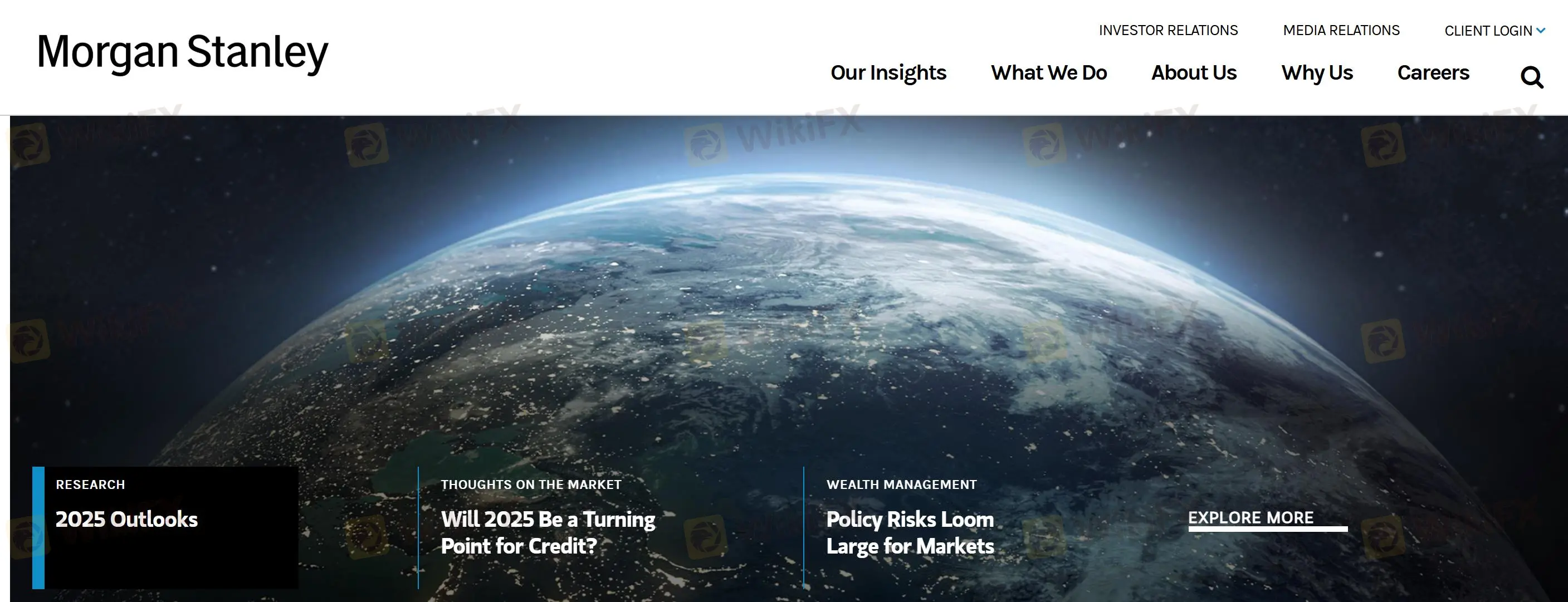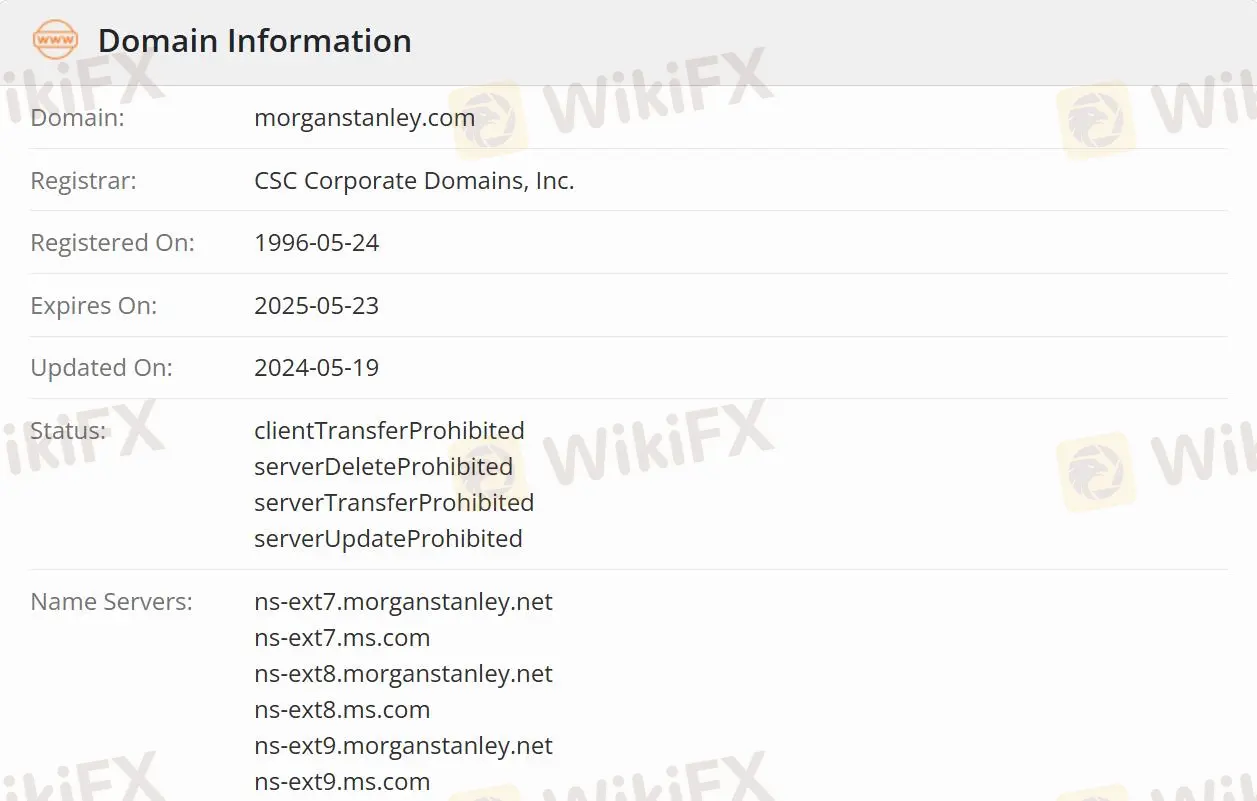Informations de base
 États-Unis
États-UnisNote
 États-Unis
|
5 à 10 ans
|
États-Unis
|
5 à 10 ans
| https://www.morganstanley.com
Site officiel
Indice de notation
Influence
AAA
Indice d'influence NO.1
 États-Unis 9.41
États-Unis 9.41 Licences
LicencesEntité agréée:Morgan Stanley Canada Limited
N° de réglementation:Non publié
Mono-cœur
1G
40G
1M*ADSL
 États-Unis
États-Unis Hongrie
Hongrie morganstanley.com
morganstanley.com États-Unis
États-Unis Hongrie
Hongrie





VACANT

Directeur général
Date de début
État
Employé
MORGAN STANLEY FUND SERVICES INC.(New York (United States))

C T CORPORATION SYSTEM

Agent
Adresse
28 LIBERTY ST., NEW YORK, NEW YORK, 10005
MORGAN STANLEY FUND SERVICES INC.(New York (United States))

R. BRIAN SMALLHORN

Directeur
Date de début
État
Employé
MORGAN STANLEY CANADA LIMITED(Canada)
| Morgan StanleyRésumé de l'examen | |
| Fondé | 1996-05-24 |
| Pays/Région enregistré(e) | États-Unis |
| Réglementation | Réglementé |
| Services | Gestion de patrimoine, Banque d'investissement et marchés de capitaux, Ventes et négociation, Recherche, Gestion d'investissement, Morgan Stanley au travail, Investissement durable et Groupe des entreprises inclusives |
| Assistance clientèle | Réseaux sociaux : LinkedIn, Instagram, Twitter, Facebook, YouTube |
Morgan Stanley est un courtier qui aide les particuliers, les familles, les institutions et les gouvernements à mobiliser, gérer et distribuer du capital.

Morgan Stanley est autorisé et réglementé par l'Organisation de réglementation des investissements du Canada (ORIC), ce qui le rend plus sûr que les courtiers réglementés. Mais les risques ne peuvent pas être complètement évités.


Le travail de l'entreprise comprend 8 aspects majeurs, notamment la gestion de patrimoine, la banque d'investissement et les marchés de capitaux, les ventes et la négociation, la recherche, la gestion d'investissement, Morgan Stanley au travail, l'investissement durable et le groupe des entreprises inclusives.
Gestion de patrimoine : Aider les personnes, les entreprises et les institutions à construire, préserver et gérer leur patrimoine.
Banque d'investissement et marchés de capitaux : Expertise en analyse de marché, services de conseil et de levée de capitaux pour les entreprises, les institutions et les gouvernements.
Ventes et négociation : Morgan Stanley pour les services de vente, de négociation et de création de marché.
Recherche : Offrir une analyse des entreprises, des secteurs, des marchés et des économies, aidant les clients dans leurs décisions.
Gestion d'investissement : Fournir des stratégies d'investissement dans différentes classes d'actifs, sur les marchés publics et privés.
Morgan Stanley au travail : Fournir des solutions financières en milieu de travail pour les organisations et leurs employés, en combinant des conseils.
Investissement durable : Offrir des produits d'investissement durables, favoriser des solutions innovantes et fournir des informations exploitables sur les questions de durabilité.
Les traders peuvent suivre Morgan Stanley sur différents réseaux sociaux, notamment LinkedIn, Instagram, Twitter, Facebook et YouTube.
| Options de contact | Détails |
| Réseaux sociaux | LinkedIn, Instagram, Twitter, Facebook, YouTube |
| Langue prise en charge | Anglais |
| Langue du site web | Anglais |
| Adresse physique | Morgan Stanley 1585 Broadway New York, NY 10036 |

Liste d'avertissement de la FCA concernant les entreprises non autorisées morganstanleyeea.com (Clone d'une entreprise autorisée par la FCA).
Pays / Région
UK FCA
Délai de divulgation
2025-07-11
Divulguer le courtier
Liste d'avertissement de la FCA concernant les entreprises non autorisées Morganprotrade (Clone d'une entreprise autorisée par la FCA).
Pays / Région
UK FCA
Délai de divulgation
2025-06-19
Divulguer le courtier


As an experienced trader, I approach questions about trading conditions with caution, especially when dealing with large institutions like Morgan Stanley. Based on the information available, Morgan Stanley operates primarily as a global investment bank and financial services provider, focusing on wealth management, investment banking, sales and trading, and institutional research. The WikiFX context notes its status as a market maker and its regulated presence in Canada, but it does not provide explicit details regarding typical spreads for retail forex products such as EUR/USD on a standard account. From my perspective, this lack of direct information on spreads is noteworthy. In my experience, investment banks like Morgan Stanley often serve institutional and high-net-worth clients rather than typical retail forex traders. Their spread structures, if they offer direct forex trading to individuals at all, would likely vary significantly depending on account size, trading volume, and the specific arrangements made with clients. This is different from the transparent fixed or floating spreads that are typically advertised by most retail-focused forex brokers. Given these considerations, I cannot specify a typical EUR/USD spread for a standard account at Morgan Stanley based on the information at hand. For retail traders, I would recommend contacting Morgan Stanley directly for precise trading terms, as relying on generalizations could expose you to unexpected costs or unsuitable account types. This cautious approach helps ensure you're operating with clear expectations and a full understanding of fee structures, which is crucial for responsible and informed trading decisions.


Having evaluated Morgan Stanley as both an experienced trader and from the lens of investor safety, I find several important risks and drawbacks worth careful consideration before committing to this broker. While Morgan Stanley operates as a globally recognized investment bank, certain aspects give me pause. For one, the broker is regulated in Canada under CIRO, which is a reputable jurisdiction, but I always remind myself that regulations in one country do not ensure the same level of protection internationally. Additionally, WikiFX highlights a “high potential risk” warning and assigns a Risk Management Index of 0.00. For me, this is concerning, as it suggests there could be deficiencies in current risk controls or a lack of transparency surrounding risk practices. A personal red flag is the presence of negative user reviews, specifically repeated complaints about problems withdrawing funds and requests for extra deposit payments when accounts are flagged. Although one positive review mentioned knowledgeable service, the withdrawal issues, especially when associated with money laundering claims and holding of funds, signal operational and possibly procedural risks that I would not ignore. Furthermore, even as a well-established institution, Morgan Stanley acts as a Market Maker. In my own experience, this means there could, in theory, be conflicts of interest with client trades, so I approach their trading services with extra caution. In summary, regulation, user complaints, and risk management signals all play into my decision-making, and I find it essential to perform additional due diligence and never assume safety purely based on reputation.


Based on my experience as a forex trader and after reviewing the available information about Morgan Stanley, it isn’t explicitly clear whether they offer fixed or variable spreads for retail trading, as their WikiFX profile emphasizes institutional services like wealth management, investment banking, and sales & trading rather than typical retail forex offerings. In my years of trading, I’ve learned that major institutions like Morgan Stanley tend to provide bespoke pricing structures for clients, particularly at the institutional or high-net-worth level, which often translate to variable spreads. From what I can infer, this means spreads are likely to adjust dynamically, especially during periods of high volatility such as major economic releases or geopolitical events. Variable spreads inherently widen when market liquidity decreases or volatility surges—a common occurrence around news events. In my own trading experience, even well-capitalized brokers are not immune to these shifts, and spreads can become significantly wider in fast-moving markets, increasing transaction costs. For traders using brokers with a market maker model, which is cited for Morgan Stanley’s Canadian operations, it’s even more critical to remain cautious during such periods, as the risk of slippage or trade rejections can also increase. Ultimately, for anyone considering Morgan Stanley for active trading, I would recommend seeking direct clarification from the broker regarding the nature of their spreads and to always exercise additional caution around high-impact news.


As someone who takes risk management very seriously, I always verify a broker’s regulatory status and key trading parameters before even considering them for forex trading. With Morgan Stanley, I noticed that while they are regulated in Canada under CIRO, WikiFX does not provide any explicit details about the maximum leverage available for major forex pairs. This lack of transparency on leverage can be a concern for retail traders like me, as it makes it difficult to evaluate whether the trading conditions fit my approach, especially since proper leverage is a fundamental part of capital preservation. From my experience, major investment banks with a focus on institutional and high-net-worth clients—like Morgan Stanley—often provide much lower leverage compared to typical retail FX brokers. Stringent Canadian regulations also tend to enforce conservative leverage limits to protect clients against significant losses. Usually, that means that, even if forex trading is available, leverage might not exceed 1:30 or 1:50, especially for the most liquid pairs, though this is an informed estimate rather than an official figure. For other asset classes, such as equities, futures, or derivatives, the leverage usually varies significantly depending on both asset type and client category. But again, without a transparent, published schedule from the broker, any prospective trader should be cautious and seek direct clarification before committing funds. In my view, the lack of clear information about leverage at Morgan Stanley underlines the importance of contacting their support or a representative for specifics—it’s simply too important to leave to assumption.



Veuillez saisir...


 TOP
TOP 

Chrome
Extension chromée
Enquête réglementaire sur les courtiers Forex du monde entier
Parcourez les sites Web des courtiers forex et identifiez avec précision les courtiers légitimes et frauduleux

Installer immédiatement